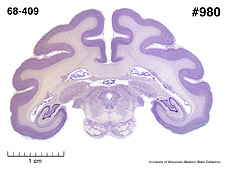|
Mantled
Howler
(Alouatta palliata) #68-409 |
||||
|
|
Physical
characteristics and distribution
|
|
Largest
of the New World monkeys, head and body lengths range from
559-915 mm, tail length 585-915mm and adult weights range
from 4- 10 kg. Color variations from yellowish brown, deep
reddish brown and black occur within species and individuals
and can change as the monkey ages. Males are usually larger
than females. Howlers have short, stout legs. They have extremely
powerful prehensile tails which are hairless on the underside
of the terminal third. The face is naked and the large lower
jaw and hyoid bone enable the monkey to emit loud, booming
vocalizations. Alouatta palliata prefers secondary forest. Adult males are dominant. Howlers live in troops of 2-45, but generally average 10-20 animals. Vocalizations are used to declare territory, which is wherever the group happens to be at the time. Adult females have an estrous cycle lasting 13-24 days and gestation ranges from 180-194 days. One infant is born and travels with its mother by clinging to her fur. As it gets older, it moves to a permanent riding position on her back. This lasts for about one year. The young is weaned at about 10 months and sexual maturity is achieved at 3-4 years for females and 5 years for males. Males, however, must attain specific social status before they can mate. Average lifespan is 16 years. They are found from W Ecuador to Veracruz and Oaxaca (Mexico). |
|
Description
of the brain
|
|
Animal
source and preparation
|
|
All
specimens collected followed the same preparation
and histological procedure.
|
Other Related Resources (websites and publications)
List of Specimens | Explore Collections | Brain Sections | Brain Evolution | Brain Development | Brain Circuitry | Brain Functions | Location and Use | Related Web Sites | Contact Us | Search MSU Database | Personnel | Home



